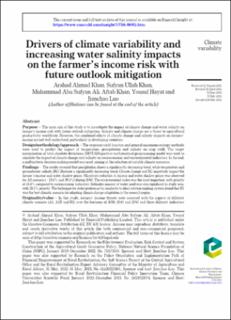| dc.contributor.author | Khan, Arshad Ahmad | |
| dc.contributor.author | Khan, Sufyan Ullah | |
| dc.contributor.author | Ali, Muhammad Abu Sufyan | |
| dc.contributor.author | Khan, Aftab Ahmad | |
| dc.contributor.author | Hayat, Yousaf | |
| dc.contributor.author | Luo, Jianchao | |
| dc.date.accessioned | 2023-03-29T12:27:03Z | |
| dc.date.available | 2023-03-29T12:27:03Z | |
| dc.date.created | 2022-09-28T10:37:10Z | |
| dc.date.issued | 2022 | |
| dc.identifier.citation | Khan, A. A., Khan, S. U., Ali, M. A. S., Khan, A., Hayat, Y., & Luo, J. (2022). Drivers of climate variability and increasing water salinity impacts on the farmer’s income risk with future outlook mitigation. International Journal of Climate Change Strategies and Management, (ahead-of-print). | en_US |
| dc.identifier.issn | 1756-8692 | |
| dc.identifier.uri | https://hdl.handle.net/11250/3060927 | |
| dc.description.abstract | Purpose
The main aim of this study is to investigate the impact of climate change and water salinity on farmer’s income risk with future outlook mitigation. Salinity and climate change are a threat to agricultural productivity worldwide. However, the combined effects of climate change and salinity impacts on farmers' income are not well understood, particularly in developing countries.
Design/methodology/approach
The response-yield function and general maximum entropy methods were used to predict the impact of temperature, precipitation and salinity on crop yield. The target minimization of total absolute deviations (MOTAD)-positive mathematical programming model was used to simulate the impact of climate change and salinity on socioeconomic and environmental indicators. In the end, a multicriteria decision-making model was used, aiming at the selection of suitable climate scenarios.
Findings
The results revealed that precipitation shows a significantly decreasing trend, while temperature and groundwater salinity (EC) illustrate a significantly increasing trend. Climate change and EC negatively impact the farmer's income and water shadow prices. Maximum reduction in income and water shadow prices was observed for A2 scenario (−12.4% and 19.4%) during 2050. The environmental index was the most important, with priority of 43.4% compared to socioeconomic indicators. Subindex amount of water used was also significant in study area, with 28.1% priority. The technique for order preference by similarity to ideal solution ranking system found that B1 was the best climatic scenario for adopting climate change adaptation in the research region.
Originality/value
In this study, farmers' income threats were assessed with the aspects of different climate scenario (A1, A1B and B1) over the horizons of 2030, 2040 and 2050 and three different indicators (economic, social and environmental) in Northwestern region of Pakistan. Only in arid and semiarid regions has climate change raised temperature and reduced rainfall, which are preliminary symptoms of growing salinity. | en_US |
| dc.language.iso | eng | en_US |
| dc.publisher | Emerald | en_US |
| dc.rights | Navngivelse 4.0 Internasjonal | * |
| dc.rights.uri | http://creativecommons.org/licenses/by/4.0/deed.no | * |
| dc.title | Drivers of climate variability and increasing water salinity impacts on the farmer’s income risk with future outlook mitigation | en_US |
| dc.type | Peer reviewed | en_US |
| dc.type | Journal article | en_US |
| dc.description.version | publishedVersion | en_US |
| dc.rights.holder | The authors | en_US |
| dc.subject.nsi | VDP::Landbruks- og Fiskerifag: 900 | en_US |
| dc.source.journal | International Journal of Climate Change Strategies and Management | en_US |
| dc.identifier.doi | 10.1108/IJCCSM-08-2021-0092 | |
| dc.identifier.cristin | 2056231 | |
| cristin.ispublished | true | |
| cristin.fulltext | original | |
| cristin.qualitycode | 1 | |

